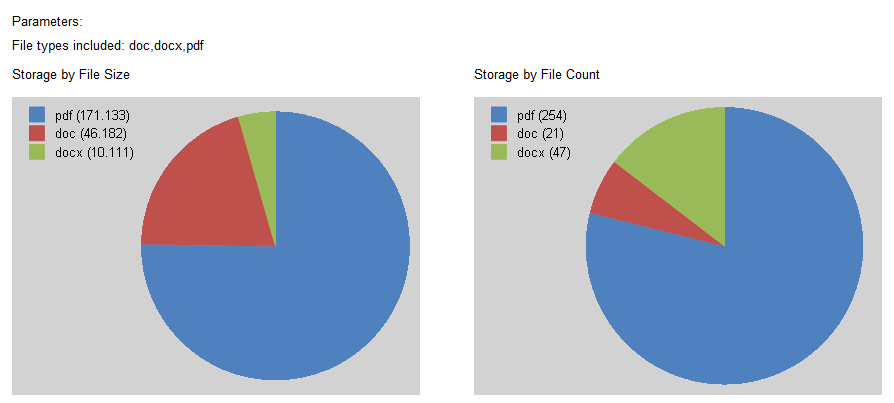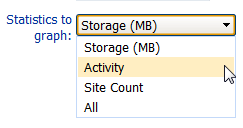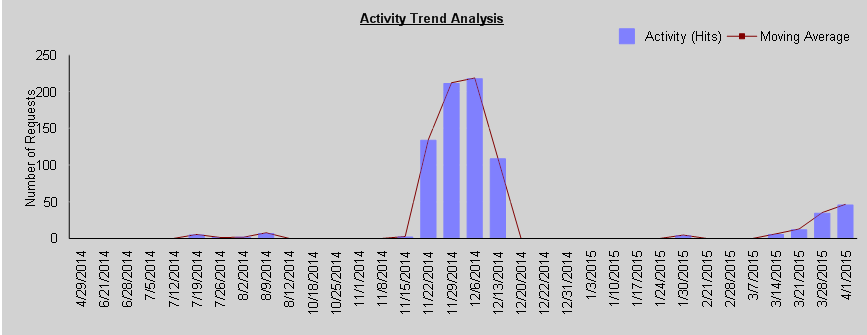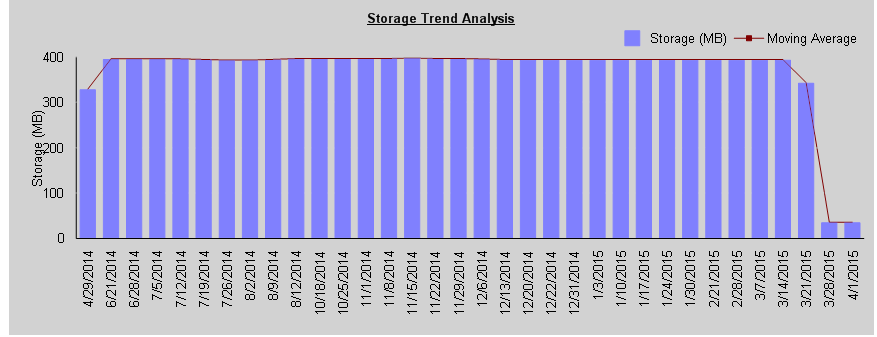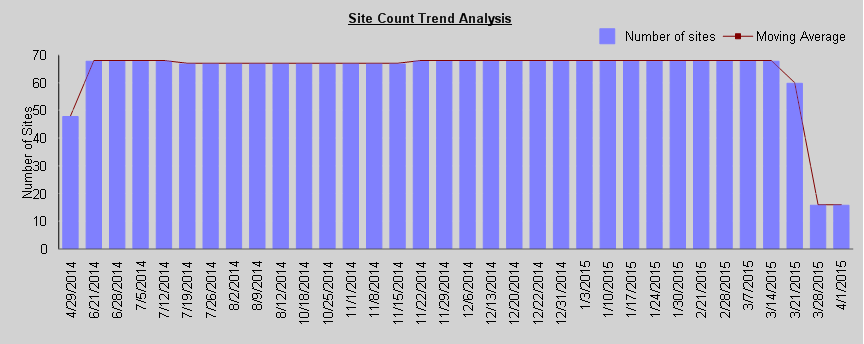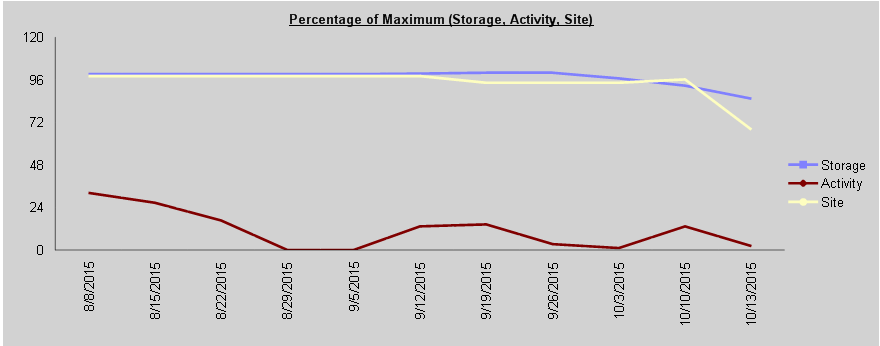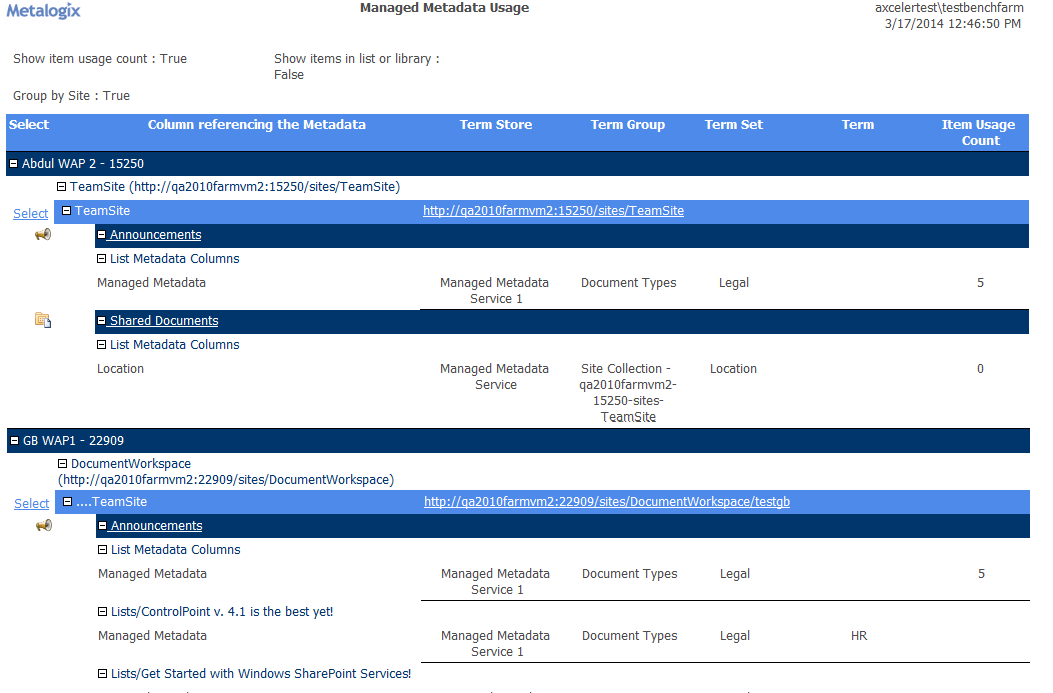Analyzing Storage by File Type
The Storage by File Type analysis provides both a graphical and tabular representation of the amount of storage used by various file types in the content database(s), both by file size and count. You have the option of including all file types, or including/excluding those with specified file extensions.
NOTE: This analysis encompasses files within SharePoint content databases. Files stored within the file system, such as SharePoint Features, are not included.
To generate a Storage by File Type analysis:
1Select the object(s) you want to include in your analysis.
2Choose Storage > Storage by File Type.
3Specify the following parameters for your analysis:
If you want include or exclude specific file types:
§Specify whether you want to Include Extensions or Exclude Extensions.
§Enter the file extension(s) you want to include or exclude in the File Extensions field. Enter multiple extensions as a comma-separated list.
NOTE: If you want include all file types, leave the File Extensions field blank. If you chose Exclude Extensions, you must enter at least one file extension.
Now you can:
·run the operation immediately (by clicking the [Run Now] button)
OR
·schedule the operation to run at a later time or on a recurring basis.
OR
·save the operation as XML Instructions that can be run at a later time.
Analysis results include:
·two pie charts that depict the Storage by File Size and Storage by Type for the selected scope and file types.
·a listing that includes the Extension(s), Total Files and Total Size (MB) for each file type.
Click an Extension(s) hyperlink to generate a Most/Least Storage analysis that shows the files with that extension that use the most storage (the number of which was specified in the Number of Files to Show in Drill-down).
Analyzing Trends
For a single farm, Web application, or site collection, you can analyze trends over a specified time period in:
·activity
·site count, and/or
·storage.
To generate a Trends analysis:
1Select the object for which you want to analyze trends.
NOTE: You can only analyze trends for one site collection at a time. If you multi-select, only the object on which you right-clicked will apply.
2Use the information in the following table to determine the appropriate action to take.
|
If you want to analyze trends in ... |
Choose ... |
|---|---|
|
activity |
Activity > Trend Analysis for Activity. |
|
site count |
Content > Trend Analysis for Site Count. |
|
storage |
Storage > Trend Analysis for Storage. |
3Specify the following parameters for your analysis:
a)Enter or select a Start Date and End Date for your analysis.
The date range you select determines the time intervals captured in the analysis, as described in the following table.
|
If the time period you specified is ... |
Then the Trend Analysis will be reported ... |
|---|---|
|
up to 60 days |
by Day |
|
between 61 and 364 days |
by Week |
|
365 days or greater |
by Month. |
b)If you want to change the Statistics to Graph, select a different value from the drop-down.
c)If you want your graph to include a line that smooths out short-term fluctuations, check the Include moving Average box.
The default value for Moving average period (days) is 7, which represents the number of days within a given week. This value is useful for many business users who can expect less activity, for example, on the weekend. You can, however, change this value to measure moving average for a different time period. For example, if you generally experience week-to-week fluctuations over the course of a month, you may choose to set the Moving average period to 31.
Now you can:
·run the operation immediately (by clicking the [Run Now] button)
OR
·schedule the operation to run at a later time or on a recurring basis.
OR
·save the operation as XML Instructions that can be run at a later time.
Trend Analysis results consist of two graphs:
·The Trend Analysis bar graph includes the statistics for the selected criterion. (Note that if you selected ALL from the Statistics to graph drop-down, a separate graph will be included for each). Below are examples of Trend Analyses by Day reports (including a 7-day moving average) for Activity, Storage, and Site Count over the same 28-day time period.
Activity Trend Analysis
Storage Trend Analysis
Site Count Trend Analysis
·The second graph is a line graph that shows statistics for all three options (activity, storage, and site count) in terms of a percentage over the course of the selected time period. Note that the maximum value (100%) represents the most storage used, greatest level of activity, and largest site count over the selected time period.
Analyzing Content
ControlPoint provides the following tools for analyzing site content:
·The Metadata Usage analysis shows where and how Managed Metadata is used in SharePoint Server farms
·The Content Types analysis shows properties and usage details of SharePoint content types.
·Web Parts by Part and Web Parts by Site include detailed statistics about Web Parts used in selected sites.
You can also analyze trends in site count over a specified time period.
Analyzing Managed Metadata Usage
The Metadata Usage analysis lets you analyze the use of managed metadata as list/library columns in your SharePoint environment. You can group results by site or by term set and you have the option to Include usage count and the individual items in lists or libraries that use the metadata.
To generate a Managed Metadata Usage analysis:
1Select the object(s) whose managed metadata usage you want to analyze.
2Choose Content > Managed Metadata Usage.
3Specify the parameters for your analysis. Use the information in the following table for guidance.
|
If you ... |
Then ... |
|---|---|
|
want results to include only metadata with term sets OR terms that contain a specific text string
|
·enter the string in Show only Metadata of TermSets/Terms containing field. NOTE: You can enter multiple text strings as a comma-separated list. ·choose the applicable Select by option (to indicate whether you want ControlPoint to search for TermSet or Term) |
|
want results to include the number of list items that have a value in the column that uses the metadata |
check the Show item usage count box. |
|
want results to include the actual list items that have a value in the column that uses the metadata |
check the Show items in list or library box. NOTE: If you check this box, ControlPoint must iterate through all list items. Depending on the scope of your analysis and the number of items within that scope, processing time may increase noticeably. |
|
want to group results by term set rather than by site |
uncheck the Group by Site box. |
Now you can:
·run the operation immediately (by clicking the [Run Now] button)
OR
·schedule the operation to run at a later time or on a recurring basis.
OR
·save the operation as XML Instructions that can be run at a later time.
If you chose to group results by site:
·The top level of the analysis shows each of the Web applications and sites within the scope of your analysis that use managed metadata
·When expanded, the following information displays each list that uses managed metadata, along with the following information:
§the name of the Column referencing the Metadata
§the Term Store, Term Group, and Term Set
§the Term specified for the list column (if applicable)
NOTE: The Term column will also show item-level terms only if the Show items in list or library box.
§if the Item Usage count parameter was checked, the number of items for which the column has been populated with metadata.
If you chose to group results by TermSet:
·The top level of the analysis shows each Term Store providing the metadata, followed by each Term Group and Term Set.
·When expanded, the following information displays for each term set:
§the site that uses the metadata
§for each list that uses the metadata:
§the name of the Column Referencing the Metadata
§if the Item Usage count parameter was checked, the number of items for which the column has been populated with metadata.
§the Term specified for the column (if applicable)
NOTE: The Term column will also show item-level terms only if the Show items in list or library box.
Note that if you have customized a term set for the site collection, SharePoint assigns the name of the Term Group.
To open the SharePoint site that uses the metadata, click on the site url.
To open SharePoint list settings page for a list, click on the list name.

